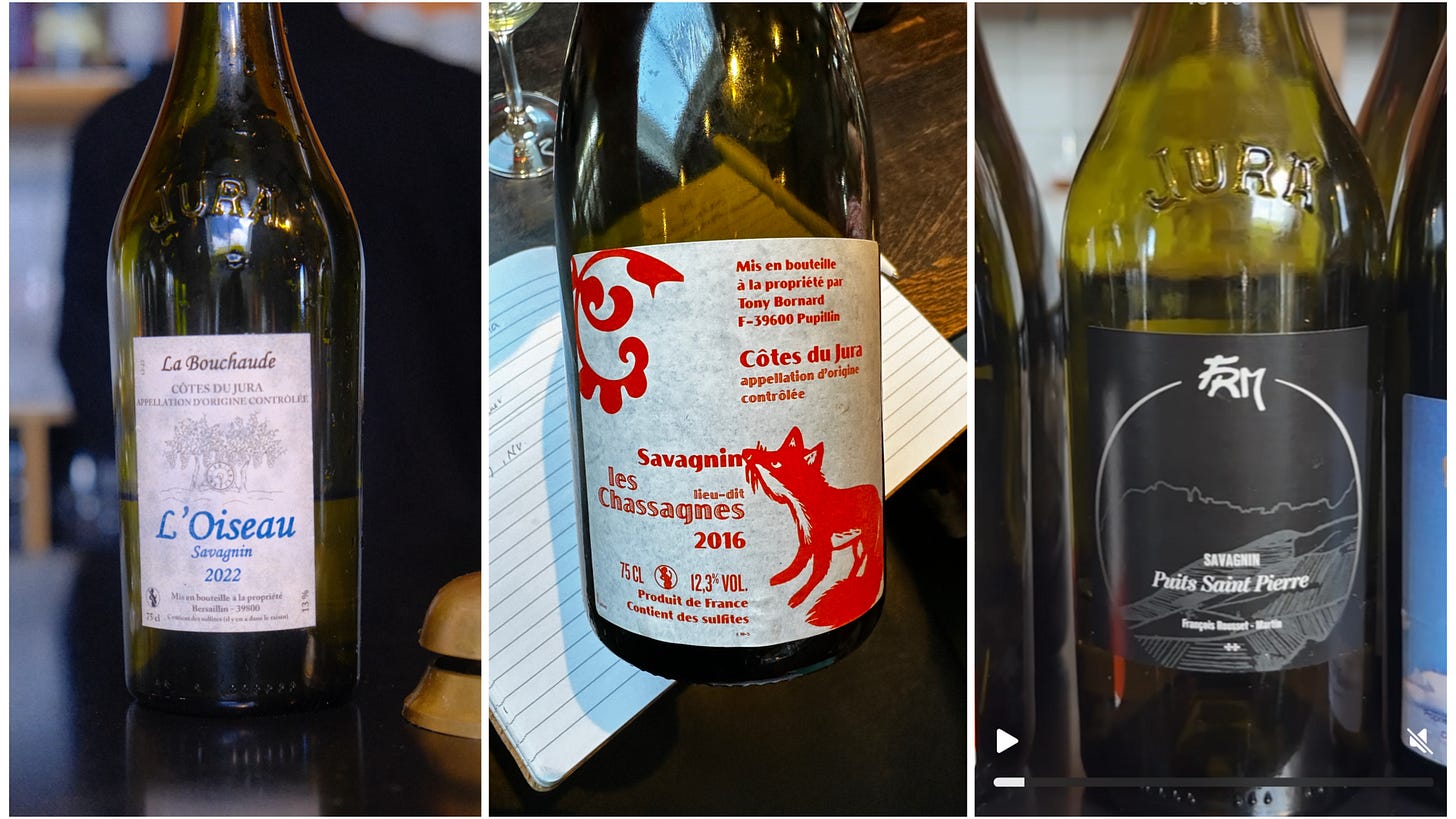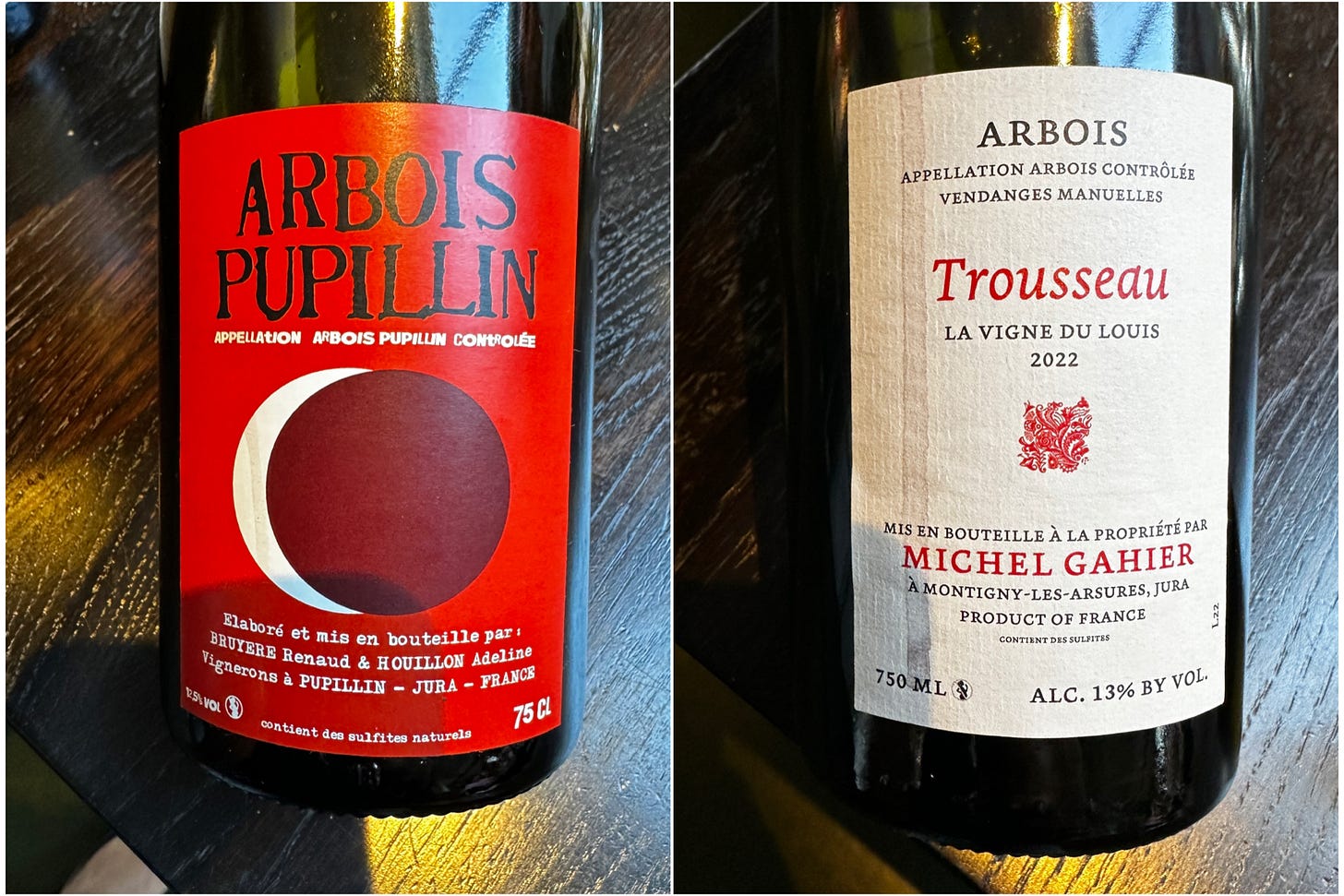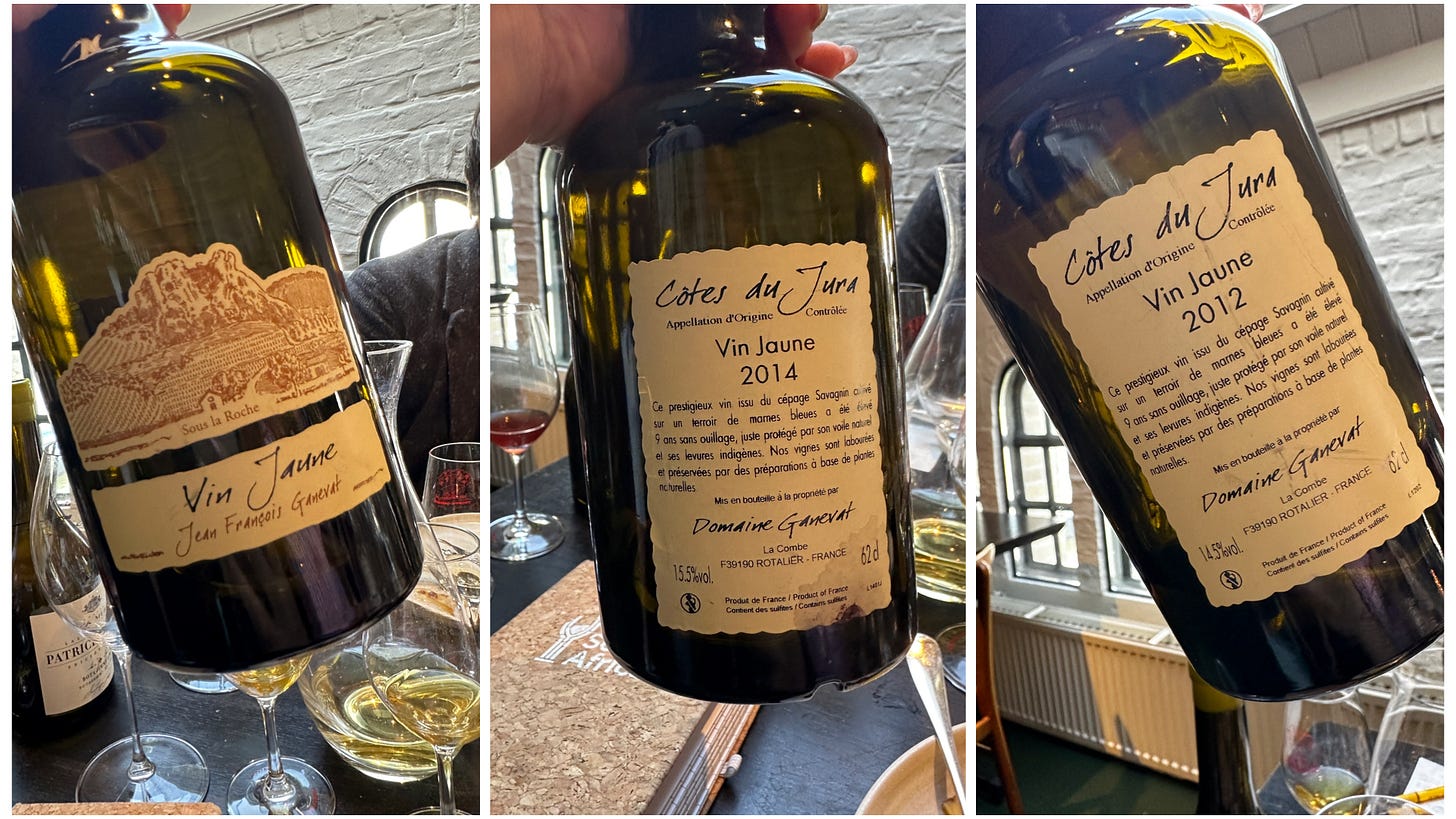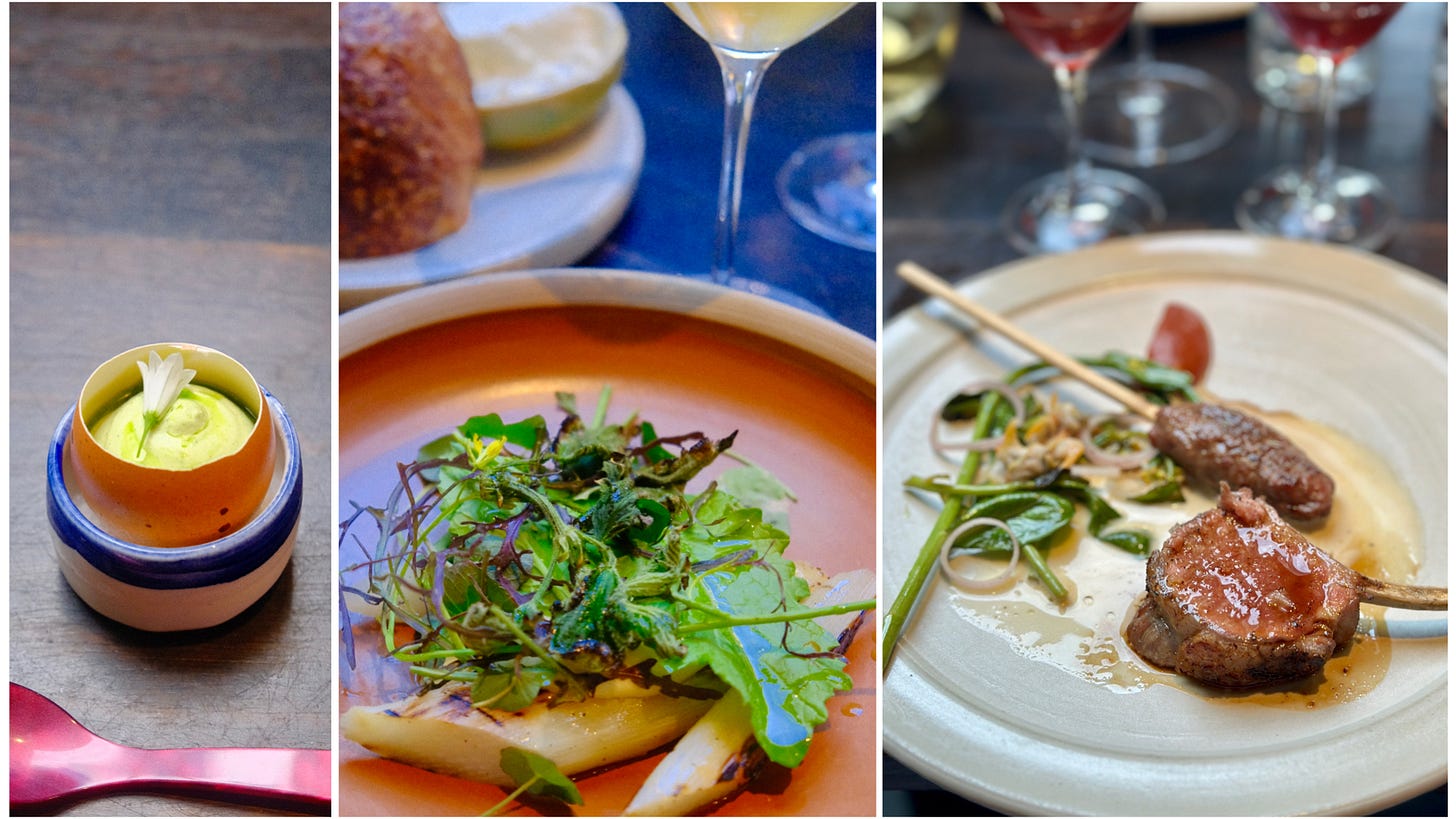The Jura Effect: A Tasting So Good, I Booked a Trip
Inside a rare wine lunch in Amsterdam—with ouillé whites, Vin Jaune, and the bottles that made me chase the Jura all the way to France.
Sunlight streamed into BAK, a serene restaurant perched above the water in Amsterdam. As the yolk of a slow-cooked egg spilled softly onto the plate, white asparagus followed—earthy, just bitter enough, and full of spring. In our glasses: hazy reds, nutty whites, and a shimmering Vin Jaune, golden and alive. That afternoon, We didn’t just share a meal—we took a journey, one plate and one bottle at a time, deep into the heart of the Jura.
The occasion was SUPREME JURA – LUNCH & WINE TASTING, where 11 meticulously chosen Jura wines were served to match the menu. But this was no ordinary tasting. Surrounding the official lineup were even more bottles, generously brought by guests—rare, aged, and deeply personal. It became a true celebration of Jura: an impromptu festival of shared devotion. Each cork pulled told its own story of affection for the region.
Jura, after all, is small. Tucked away in the eastern edge of France, it accounts for less than 0.5% of the country’s wine production. And yet, its bottles appear on the shelves of serious wine bars, at natural wine tastings, and in the cellars of Burgundy collectors. Jura wines are unmistakable—raw, soulful, precise—and they linger in the mind long after the glass is empty. Jura opens its arms wide—it’s a region that rewards curiosity and meets it with quiet brilliance.
This post isn’t just a reflection on a memorable lunch—it’s also an invitation to explore what makes Jura so compelling. Along the way, I’ll draw on foundational wine knowledge to unpack the region’s geography, wine styles, and key producers, so that by the end, you won’t just know what was in our glasses—you might find yourself reaching for a bottle of Jura, too.
Where Is Jura, and Why Does It Matter?
– A small place with a strong sense of self –
Tucked between Burgundy and Switzerland, the Jura region is easy to miss on a map—but impossible to forget once you’ve tasted its wines. This narrow strip of vineyards stretches along the western edge of the Jura Mountains, just east of the Saône plain. While nearby Burgundy is famed for its gentle hills and predominantly east-facing slopes, Jura’s topography faces more to the west, as its vineyards tilt toward the Saône River and away from the rising Jura peaks.
That positioning makes a difference. Jura receives far more rainfall than Burgundy—around 1,100 mm annually compared to Burgundy’s 700 mm—and is more exposed to extreme weather events like hail, spring frosts, and storms. As a result, yields in Jura tend to fall well below the maximum levels permitted by AOC regulations, even in good years. And yet, remarkably, organic and biodynamic farming is widespread here, embraced by both new-wave and established producers despite the region’s climatic challenges.
Geologically, the Jura shares much of the same Jurassic limestone and marl that defines Burgundy, and you’ll often hear comparisons between the two. But the wines—and the mindset behind them—are entirely distinct. If Burgundy whispers refinement, Jura speaks in a rawer, more elemental tone. There’s less pursuit of perfection, more celebration of imperfection. Wines here are shaped not just by terroir, but by philosophy.
Despite of the size, Jura has an outsized identity. Its wines span a remarkable spectrum: from oxidative Savagnin aged under a veil of yeast (sous voile), to topped-up Chardonnay with a saline edge (ouillé), to pale, expressive reds made from Poulsard and more structured Trousseau. The region resists easy classification, but once you start to understand it, the pieces fall beautifully into place.
In the next section, we’ll explore these styles more closely, using the wines from our lunch as a guide.
Tasting the Styles: From Freshness to Oxidation
Due to the vast stylistic range, it’s not uncommon for even the smallest producers to craft 10 to 15 different wines in a single vintage. At our tasting lunch, we opened with mineral-driven ouillé whites, moved through pale to more structured reds, and finished with the region’s most iconic oxidative expressions. Across just a few courses, we tasted wines that ranged from gentle and saline to bold and nutty. It was a masterclass in contrast, coherence, and character.
🟡 Savagnin Ouillé: Jura’s Quiet Revolution
In Jura, Savagnin is traditionally associated with oxidative styles like Vin Jaune. But when it’s ouillé—topped up during aging to avoid oxidation—it reveals a completely different side: taut, flinty, and brimming with alpine freshness.
Ouillé, meaning “topped up,” is not legally defined in Jura’s AOC regulations. On bottles, this style may appear as “Nature,” especially in AOC Arbois, or simply left unmentioned, leaving it to the drinker (or sommelier) to discover.
In contrast to sous voile wines, meaning “controlled oxidation“, Savagnin ouillé is typically made reductively, with minimal oxygen exposure during aging (élevage). It showcases the grape’s natural acidity, minerality, and complexity, without the nutty, spicy notes that come from oxidative aging.
Here are two examples that brought this style into sharp focus:
🍷 L’Oiseau 2022 –Savagnin, La Boucharde
Flinty and slightly smoky at first, with citrus zest, grapefruit pith, and green apple on the nose. The palate was juicier and more layered than expected—herbal tones and a touch of bread dough added savory depth to the wine’s fresh, textured profile.🍷 Les Chassagnes 2020 – Savagnin, Tony Bornard (Note: the photo shows the 2016 vintage, but the tasting note refers to the 2020)
Pure and precise, with bright citrus juice and a hint of struck match on the nose. The palate is lean and linear, driven by racy acidity. Clean and focused, this wine emphasizes tension and clarity over richness. I’d love to revisit it after another three years of aging.🍷 Puits Saint-Pierre 2022 – Savagnin, François Rousset-Martin
Most powerful, with obvious oak influence. Aromas of yellow peach, quince, citrus peel, cream, a touch of butter, and hazelnuts made for an open, inviting nose. On the palate, the wine was already mellow and well integrated, even in its youth, yet a thread of refreshing acidity gave it clarity and precision. Accessible, but built to hold its shape.
⚪ Chardonnay Ouillé: Salinity Over Showiness
Chardonnay is the most widely planted grape in Jura, but much of it is used for the region’s traditional method sparkling wine, Crémant du Jura. When made as a still wine—especially in the ouillé style—it reveals a character that’s both refined and deeply expressive.
Despite its genetic and geological ties to Burgundy, Jura Chardonnay offers taut acidity and a distinct salty edge, captivating lovers of high-acid, mineral-driven whites. The best examples combine precision and silkiness, with layers of citrus, herbs, leesy creaminess, and a spine of freshness that cuts through even richer meals.
We tasted what many Jura lovers would consider a dream trio—three wines that reflect the outer limits of what ouillé Chardonnay can achieve in the region.
🍷 Mizuiro – Chardonnay, Kenjiro Kagami 2016
A true unicorn wine in Jura. Restrained on the nose, yet precisely expressive on the palate. Complex layers of lemon zest, melon, white flowers, honey, and hazelnuts unfold harmoniously. The noble saline acidity is juicy and integrated, leading to a long, precise, and persistent finish. Impeccable balance between silkiness and energy—the most impressive wine of the day. (Let’s just agree not to talk about the price—it’s probably not what the producer ever intended.)🍷 Les Parcelles Rares La Bardette – Chardonnay, Labet 2016
A wine that demands air—or a generous glass—to fully open. Made from vineyards very close to Mizuiro, it offers a similarly noble character. The nose blends citrus, struck match, crushed rocks, hazelnuts, lemon zest, and grapefruit. On the palate, it shows bracing acidity wrapped in a creamy texture. Structured, intense, and effortlessly elegant.🍷 Les Chalasses Vieilles Vignes Ouillé – Ganevat 2012
More evolved, with aromas of sweet dried apricot, mango, citrus zest, honey, and ripe lemon—a reflection of the warmer vintage. Rich and textural, with layered complexity now leaning into tertiary notes. I wish I could compared the same vintage 2016.
🔴 Poulsard & Trousseau: Pale Color, Deep Character
Jura’s red wines are often visually deceptive—pale in the glass, yet full of nuance. The two primary red varieties, Poulsard (also spelled Ploussard) and Trousseau, together make up about 21% of total production, offering an expressive alternative to more muscular reds.
Poulsard is the lighter of the two, often translucent and perfumed, with notes of red berries, dried flowers, and forest floor. It’s a grape that thrives on subtlety and finesse.
Trousseau, while still light by international standards, brings more structure, spice, and darker fruit—and is often used solo or in blends.
These two bottling beautifully showcased the range of Jura reds:
🍷 Poulsard – Bruyère Houillon 2016
Slightly funky at first (a touch of acetone), but it blew off. Pale and ethereal, with aromas of wild strawberry, rosehip, pomegranate, and floral herbal tea. The texture was soft and fine, yet the wine carried surprising length. Elegant, fragile, and haunting—like a faded watercolor with unexpected depth.🍷 Les Vignes de Louis – Michel Gahier 2022
Reminiscent of a youthful, pure Pinot Noir. A bright wine showing cranberry, red cherry, and raspberry, with vivid acidity and tangy fruit lifted by light herbal notes. More direct and less meditative, but full of charm and drinkability.
🟠 Vin Jaune & Château Chalon: Jura’s Most Iconic Wines
If ouillé wines express Jura’s elegance, Vin Jaune reveals its wild soul. Made exclusively from Savagnin and aged for at least six years and three months under a veil of yeast (sous voile) without topping up, Vin Jaune is oxidative by design. The result is a wine like no other: nutty, salty, spicy, bone-dry, and almost indestructible.
At our lunch, we tasted four remarkable examples, including treasures generously shared by guests:
🍷 Vin Jaune – Domaine de la Borde 2016
Lifted and expressive, with aromas of walnuts, dried citrus peel, and white mushrooms. On the palate, it was dry and intense, with a firm backbone of acidity and a lingering savory finish. Light and youthful by Vin Jaune standards, but already showing depth and complexity.🍷 Château Chalon – Tissot 2014
If Vin Jaune is Jura’s spiritual core, then Château Chalon is its sacred ground. This tiny AOC, perched on limestone cliffs above the village of the same name, produces only Vin Jaune—and only in the best years. In weaker vintages, the appellation may choose not to bottle under its name at all, preserving its legendary reputation for purity and longevity.The 2014 from Tissot was elegant and composed, with lifted notes of preserved lemon, toasted almonds, wild herbs, and dried hay, underpinned by a whisper of flor-like yeastiness. The oxidative character was finely etched rather than overpowering—more clarity than density. On the palate, it was saline, structured, and endlessly layered, with a long, tapering finish that seemed to hum with quiet energy.
🍷 Vin Jaune – Jean-François Ganevat 2012 & 2014
A rare side-by-side of two Vin Jaune vintages from Ganevat, a producer whose oxidative wines are as precise as they are soulful.The 2014 showed remarkable freshness yet integration—lifted aromatics of green walnut, preserved lemon, yellow curry, and chamomile. The palate was taut and energetic, with a briny, zesty core that stretched into a long, mouth-coating finish. Still youthful, but already expressive and full of clarity. The standout wine of the flight.
The 2012 had entered a deeper, more contemplative phase. Aromas of roasted hazelnuts, dried apricot, saffron, and aged wood gave it a layered, meditative complexity. The palate was broader and more oxidative in tone, showing savory spice and earthy depth—a beautiful illustration of what time under voile can become.
Tasting them together was like listening to two movements of the same symphony—one bright and rising, the other rich and reflective.
Final Thoughts: When Wine and Place Meet on a Plate
The wines were extraordinary on their own, but it was the interplay with food that gave them new dimension. Each course served not just as a pairing—but as an echo of Jura itself.
The opening egg custard, delicate and savory, amplified the gentle salinity of the ouillé Savagnin. The creamy texture softened the wine’s acidity and adding creaminess while letting the citrus and herbal notes shine through. It was a quiet but confident start—like Jura whispering hello.
Next, the grilled white asparagus with fresh greens brought out the full spectrum of ouillé Chardonnay. The smoke, the slight bitterness of spring greens, the softness of the vegetable—all of it invited the wines to stretch out, showing depth, clarity, and that signature mineral tension.
Then came the lamb: juicy, earthy, and deeply satisfying. It met its match not in a bold red, but in the translucent strength of Poulsard and the grounded elegance of Vin Jaune. The reds offered brightness and contrast; the Vin Jaune leaned in with umami, pulling the dish into harmony with its savory core.
By the end of the meal, it was clear: Jura isn’t just a region. It’s a mood, a philosophy, and in the right hands, a complete experience.
We finished, of course, with Comté cheese—though I forgot to take a photo, the pairing with Vin Jaune needed no documentation. It was everything it’s said to be: nutty with nutty, savory with savory, a moment of pure Jura clarity. It was so transporting, in fact, that I booked a trip to the Jura the very next day.
Let’s Pair the World
Ever had a wine so transportive it made you open a map, not just a second bottle? That was Vin Jaune and Comté for me—so good, I booked a short summer trip to Jura the next day. Sometimes pairings don’t just elevate a dish. They change your plans.
Have you ever chased a wine to its birthplace? Or had a pairing that unlocked a place you'd never considered? I’d love to hear about it.
Drop it in the comments, reply to this post, or DM me on Instagram (@kazuming.wine.food). If it inspires a future pairing (or itinerary), I’ll feature it in an upcoming Friday post.
This post is part of my Friday series on Asian food and wine, and complements my Tuesday Sake 101 series, where I explore the fundamentals of Japanese sake through a wine-lover’s lens.
Thank you for reading Pairing the World: Wine, Sake, and More!
Each post involves hours of tasting, research, and the occasional moment of geographic impulse.
👉 If this post transported you—or made you want to book a trip to Jura too—hit that free subscribe button below. Each week I share stories like this, plus pairings, discoveries, and cultural flavor adventures. Let’s explore the delicious unknown together.










